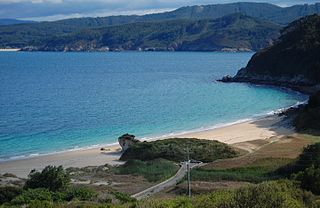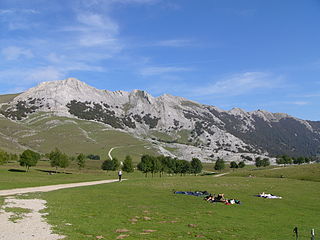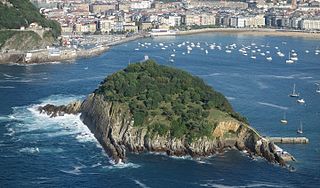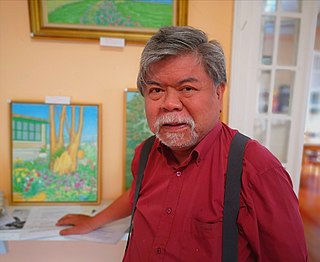
The Bay of Biscay is a gulf of the northeast Atlantic Ocean located south of the Celtic Sea. It lies along the western coast of France from Point Penmarc'h to the Spanish border, and along the northern coast of Spain, extending westward to Cape Ortegal. The southern area of the Bay of Biscay that washes over the northern coast of Spain is known locally as the Cantabrian Sea.

Gipuzkoa is a province of Spain and a historical territory of the autonomous community of the Basque Country. Its capital city is Donostia-San Sebastián. Gipuzkoa shares borders with the French department of Pyrénées-Atlantiques at the northeast, with the province and autonomous community of Navarre at east, Biscay at west, Álava at southwest and the Bay of Biscay to its north. It is located at the easternmost extreme of the Cantabric Sea, in the Bay of Biscay. It has 66 kilometres of coast land.

Orio is a fishing town located in the province of Gipuzkoa in the Basque Autonomous Community, northern Iberia, with the town nucleus lying on the river Oria, roughly one mile away from its mouth by the Bay of Biscay. Orio had a population of 5,901 inhabitants as of 2016.

Pasaia is a town and municipality located in the province of Gipuzkoa in the Basque Autonomous Community of northern Spain. It is a fishing community, commercial port and the birthplace of the famous admiral Blas de Lezo and of the fashion designer Paco Rabanne.

Atxondo is a municipality located in the province of Biscay, in the Basque Country, Spain. Atxondo is part of the comarca of Durangaldea and has a population of 1,447 inhabitants as of 2007 according to the Spanish National Statistics Institute.

Izurtza is an elizate, town and municipality located in the province of Biscay, in the Basque Country, Spain. Izurtza is part of the comarca of Durangaldea and has a population of 270 inhabitants as of 2010 and according to the Spanish National Statistics Institute.

Mañaria is an elizate, town and municipality located in the province of Biscay, in the Basque Country, Spain. Mañaria is part of the comarca of Durangaldea and has a population of 459 inhabitants as of 2006 according to the Spanish National Statistics Institute.

Getaria is a town on the Urola coast, in the province of Gipuzkoa, in the autonomous community of the Basque Country, in northern Spain. It borders Zarautz to the east and Zumaia to the west.

The Kursaal Congress Centre and Auditorium is a complex comprising several spaces: a great auditorium, many-use halls and exhibition halls. It was designed by Spanish architect Rafael Moneo, and is located in Donostia-San Sebastián. It opened in 1999.

San Sebastián, officially known by the bilingual name Donostia / San Sebastián, is a city and municipality located in the Basque Autonomous Community, Spain. It lies on the coast of the Bay of Biscay, 20 km from the France–Spain border. The capital city of the province of Gipuzkoa, the municipality's population is 188,102 as of 2021, with its metropolitan area reaching 436,500 in 2010. Locals call themselves donostiarra (singular), both in Spanish and Basque. It is also a part of Basque Eurocity Bayonne-San Sebastián.

Jaizkibel is a mountain range of the Basque Country located east of Pasaia, north of Lezo and west of Hondarribia, in Spain, with 547 m (1,795 ft) at the highest point. The range stretches south-west to north-east, where it plunges into the sea at the Cape Higuer. To the north-west, the mountain dips its slopes in the sea with beautiful cliffs all along, overlooking on the east the marshes of Txingudi, the river Bidasoa and its mouth as well as the towns of Irun, Hendaia and Hondarribia on the riverbanks. The nearest relevant mountains are La Rhune, Aiako Harria and Ulia, closing the view east to west from the south. Some people consider Jaizkibel to be the first westernmost mountain of the Pyrenees.

Urgull, deriving from Gascon etymology meaning 'pride,' is a prominent hill located near the ocean within the Basque city of San Sebastián, Gipuzkoa, Spain. Rising to a height of 123 meters at its peak, Urgull contributes to the city's coastal topography along with Mount Ulia and Igeldo. Situated at the northern end of a peninsula between the river Urumea and the Bay of La Concha, Urgull was previously connected to the mainland by sand.

The Aizkorri-Aratz Natural Park is the second-largest natural park in the Basque Country. Straddling the Cantabrian-Mediterranean watershed, it is named Aizkorri and Aratz, the two most notable mountains in the park. Declared a natural park in 2006, the area contains limestone mountains and as well as dense beech forests.
Tourism in the Basque Autonomous Community has increased considerably in recent years, and is a popular destination for tourists from Spain and France. According to data from the Eustat the number of tourists entering the region in the year 2009 was 1,991,790, with the final result still pending. 71% of the yearly visitors come from the rest of Spain; the greatest number from Madrid Autonomous Community (14.2%), and Catalonia (11.1%). International visitors make up the remaining 29% - the largest percent come from France (7.2%). 62% of the people who come to the Basque Autonomous Community visit one of the three capitals, 27% visit inland and 11% visit the coast. The average stay of the visitors is 2 days.

Santa Clara Island is an island located in San Sebastián, Spain, in the middle of the bay of Donostia. It is located between the two most important mountains of the city, Urgull and Igueldo.
The Basques were among the first people to catch whales commercially rather than purely for subsistence and dominated the trade for five centuries, spreading to the far corners of the North Atlantic and even reaching the South Atlantic. The French explorer Samuel de Champlain, when writing about Basque whaling in Terranova, described them as "the cleverest men at this fishing". By the early 17th century, other nations entered the trade in earnest, seeking the Basques as tutors, "for [they] were then the only people who understand whaling", lamented the English explorer Jonas Poole.
Martutene is a neighbourhood situated south of Donostia-San Sebastián, Guipúzcoa (Spain) on the banks of the river Urumea, between the neighbourhoods of Loiola, and the village of Astigarraga. In this neighbourhood, are located an industrial area, a football pitch for lower leagues, a disused vocational training building, and a prison that carries its name, Prison of Martutene.

The Park of Nurseries of Ulia lies at the neighbourhood of Ulía in Donostia-San Sebastián, extending over 14.500 m2 at the start of the Walk of Ulia, in the crossing with Jose Elosegi street. It is also named Lore-Baratzak Park on account of the nurseries held inside, which provided the plants for the public gardens of Donostia-San Sebastián during all the 20th century and until 2008, when the city council moved these municipal nurseries to Lau Haizeta.

Antonio "Tony" Diestro Pájaro is a painter from the Philippines. Born in Manila, he studied Fine Arts and then took complementary courses in the University of the Philippines (1970), in the University of Bilbao, in the University of the Basque Country (1983), and also researched the art and culture of the Philippine tribes Ifugao, Hanunoo, B'Iaan and T'Boli (1988).
Radio Océan/Atlantic 2000 was a peripheral radio station, audible on the French Atlantic coast from the Basque Country to Brest. It transmitted in medium wave of 273 m, from a transmitter located in Mount Ulia, near San Sebastián (Spain).
















